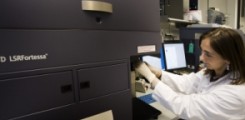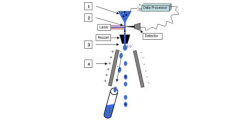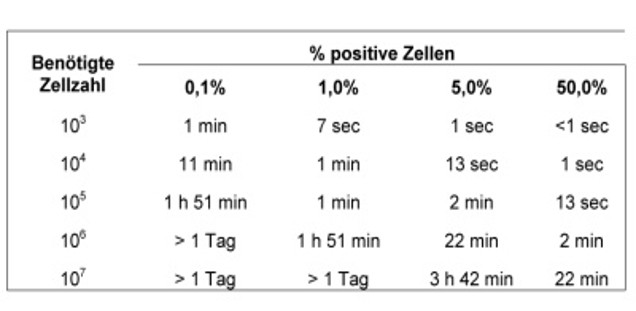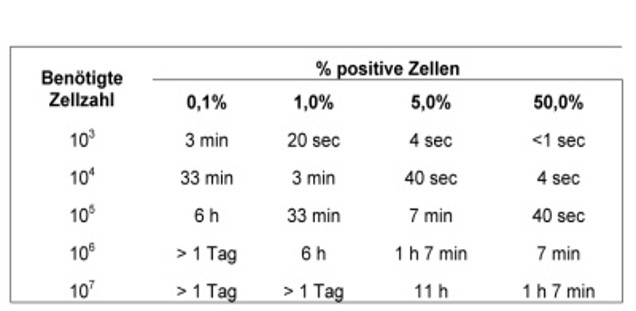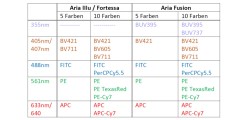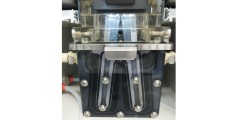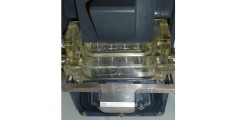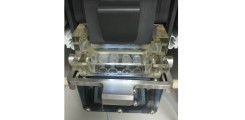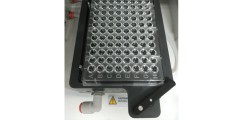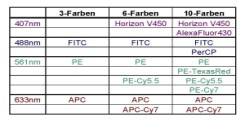Cytometry and Cell Sorting Core Facility
The aim of the Cytometry and Cell Sorting Core Facility is to provide interested scientists with access to state-of-the-art flow cytometry equipment .
- 5 Analyzers (A3, Quanteon, LSR Fortessa (4 Laser), LSR Fortessa (5 Laser) and Aurora
- 3 Sorters (AriaIIIu, AriaFusion and S6 SE)
- 1 Imaging Analyzer (ImageStream)
The analyzers can be used independently after prior training and acceptance of the terms of use (also offered as a service). Both sorters, the AriaIIIu and the AriaFusion are operated by the facility staff.
If you require instruction, support or advice on operating the devices, please contact us.
Services
- Cell Sorting with the AriaIIIu, AriaFusion and S6 SE
- Sorting of untested human samples and bacteria (AriaFusion)
- Cell analysis with the A3, Quanteon, LSR Fortessa 4-laser and 5-laser and Aurora
- Determination of absolute cell counts on the Quanteon
- Analysis of cell cycle on the Quanteon
- High resolution images can be combined with quantifiable results (stained marker) on the imaging flow cytometer Image Stream
- Analysis of vesicles and microparticles on the Image Stream
- Provision of evaluation stations for independent use with the following software: DIVA, FLOWJo, NovoExpress, Infinicyt and Ideas Software
- Introductory training and support for new users on the analysis devices for independent use
- Training of users with many years of flow cytometry experience on the sorters, AriaIIIu and AriaFusion, for independent use
- Measurement of the latest fluorescent proteins possible through acquisition of new filters
- Regular training courses on flow cytometry in cooperation with the device manufacturers
Cell Analysis
-
Aurora (in HCTI room 04.2.022)
Aurora
For high compexity applications there is the aurora as high end flowcytometer available in the core facility. It is equipped with the 3 standard lasers plus a yellowgreen and a uv-laser. Because this cytometer is a spectral cytometer (64 fluorescence channels + 3 scatter channels) you can use fluorochromes with similar fluorescence emissions.
The result of samples with high autofluorescence can be improved by autofluorescence extraction. -
A3 (in HCTI room 04.2.022)
The LSR Fortessa A3 is our highend flowcytometer for getting the most information out of your sample. The device provides the 3 standard lasers plus a yellow-green and an uv-laser. It is possible to use up to 29 parameters in your sample.
The device is equipped with the following lasers:
- 355 nm: UV laser
- 405 nm: Violet laser
- 488 nm: Blue Laser
- 561 nm: Green laser
- 640 nm: Red Laser
-
LSR Fortessa with 5 lasers (in CF1 room 00.068)
The LSR Fortessa 5L is for relief of the A3. Up to 18 fluorescences can be used in a sample.
The device is equipped with the following lasers:
- 350 nm: uv laser
- 405 nm: violet laser
- 488nm: blue laser
- 561 nm: green laser
- 640 nm: red laser
-
LSR Fortessa with 4 lasers (in CF1 room 00.068)
The LSR Fortessa allows, in addition to the blue, violet and red laser a yellow-green laser for better detection with the use of PE-dyes and red fluorescent proteins. Up to 17 fluorescences can be used in a sample.
The device is equipped with the following lasers:
- 405 nm: violet laser
- 488nm: Blue Laser
- 561 nm: green laser
- 640 nm: Red Laser
-
Quanteon (in CF1 room 0.068)
The quanteon is equipped with 4 lasers. The special feature of this device is the determination of absolute cell counts.
Furthermore the software provides analysis wizards for cell cycle and proliferation experiments.
The quanteon can be used independently for multicolour experiments or as a service.
The device is equipped with the following lasers:
- 405 nm: violet laser
- 488nm: blue Laser
- 561 nm: green laser
- 637 nm: red Laser
Cell Sorting
-
FACS Sorting - The principle
1. Cells are harvested by a sheath flow as beads strung on a string (hydrodynamic focusing)
2. In the laser intersection the analysis of the cells takes place.
3. The nozzle separates the jet into individual drops and charges the drops to be sorted on.
4. The charged drops are deflected in an electric field, and fall into the appropriate receptacle.
-
Sorting: duration
The following tables show how long a sorting operation. These are minimum hours, 20 minutes should be allocated for the setting of the device. The duration varies with the size of the cells.
-
Sorting: multicolor experiments
Examples for multicolor analysis
-
Sorting: different sample collections
The following options are possible with the FACS Aria III and FACS Aria Fusion:
1) separated into 2 populations in 15 ml tubes
2) seperated into up to 4 populations in FACS-tubes or small reaction tubes
3) filing in microtiter plates (for example, 96-well)
-
Aria IIIu (in CF1 room 0.068.1)
With this device one or more cell populations from the suspension can be sorted out (Note: not all cells can be sorted well, sometimes the populations are very sensitive). The sorted cells can be cultivated further.
The cell sorting on AriaIIIu is handled by employees of the Core Facility. The device is equipped with the following lasers:
- 407 nm: violet laser
- 488nm: Blue Laser
- 561 nm: green laser
- 633 nm: Red Laser
-
AriaFusion (in CF1 room 00.068.1)
The device is equipped with the following lasers:
- 355 nm: uv laser
- 405 nm: violet laser
- 488nm: blue laser
- 561 nm: green laser
- 640 nm: red laser
-
S6 SE (in HCTI room 04.2.22)
The device is equipped with the following lasers:
- 355 nm: uv laser
- 405 nm: violet laser
- 488nm: blue laser
- 561 nm: green laser
- 637 nm: red laser
The S6 is equipped with the following new features:
- 6-way sorting
- spectral unmixing
Further Equipment
-
Imaging Flow Cytometer (in CF1 room 0.068.1)
Technical data:
Laser:
- 488 nm blue laser (high-power)
- 642 nm red laser
- 785 nm far red laser
- 375 nm UV laser
- 405 nm violet laser
- 561 nm green laserSpeed:
- up to 200 events per secObjective
-20x, 40x und 60x magnicficationSample characteristics:
- Volume: 20-200yl
- Utilization efficiency: up to 95%
Registration
The Cytometry and Cell Sorting Core Facility is open to all researchers at the UKE and other interested parties. Bookings can be made via the internet booking system provided. New users should contact the specified contact persons directly.
There is flat fee per hour of use, which is calculated on the basis of the required consumables. The usage fee for UKE employees is (as of April 2024):
• Aurora 35 € per hour
• A3 (5 laser) 25 € per hour
• LSR Fortessa (5 laser) 25 € per hour
• Quanteon (4 laser) 24 € per hour
• LSR Fortessa (4 laser) 22 € per hour
• AriaIIIu 60 € per hour
• AriaFusion 60 € per hour
• S6 SE 60 € per hour
• Image Stream 55 € per hour
The total usage time for each working group is determined on a quaterly basis and billed either via cost center or third-party funds. Please note the usage regulations for the individual devices.
Contact
Location CF1 (N27)
- lab: room 0.068 + 0.068.1 > tel. 52306 (best accessibility)
- office: room 0.066 > tel. 39677
Location HCTI (N25)
- lab: room 04.2.022 + 023.2 > tel. 50036
- office: room 04.2.037 > tel. 39644
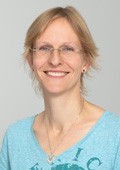
_3_kontaktbild.jpg)
- Research fellow
- Cytometry and Cell Sorting Core Unit

- Medical-technical laboratory assistant
- Cytometry and Cell Sorting Core Unit

